CIC: Difference between revisions
(Fleet > Fleet (RDM)) |
Steelviper (talk | contribs) (→Tactical Station: FLeet -> Fleet. the wiki is VERY case sensitive) |
||
| Line 43: | Line 43: | ||
As ''Galactica's'' computers aren't networked, the Tactical officer must manually print or offload data from the various central computers he monitors (Fire control, Navigation, FTL, and mainframe computers) and relay this information to the other officers and staff in the room. Fortunately, many stations see the same information on displays similar to those at the Tactical Station, but it's the Tactical Officer who is charged with notifying the commander of the changes and interpreting the results. ''Galactica's'' Tacthcal officer also is the administrator for all central computers onboard and provides maintenance as required. | As ''Galactica's'' computers aren't networked, the Tactical officer must manually print or offload data from the various central computers he monitors (Fire control, Navigation, FTL, and mainframe computers) and relay this information to the other officers and staff in the room. Fortunately, many stations see the same information on displays similar to those at the Tactical Station, but it's the Tactical Officer who is charged with notifying the commander of the changes and interpreting the results. ''Galactica's'' Tacthcal officer also is the administrator for all central computers onboard and provides maintenance as required. | ||
While the Helm officers drive the ship, it is the Tactical officer that plots ''[[FTL|Jumps]]'', the apparently instantaneous leap from one location in space to another location millions of kilometers away. The Tactical officer of ''Galactica'' not only has to provide Jump coordinates to the battlestar's helm, but also relay a series of scheduled and emergency Jump coordinates to over 70 other FTL-capable civilian ships that make up [[The | While the Helm officers drive the ship, it is the Tactical officer that plots ''[[FTL|Jumps]]'', the apparently instantaneous leap from one location in space to another location millions of kilometers away. The Tactical officer of ''Galactica'' not only has to provide Jump coordinates to the battlestar's helm, but also relay a series of scheduled and emergency Jump coordinates to over 70 other FTL-capable civilian ships that make up [[The Fleet (RDM)|the Fleet]] to ensure that all ships always stay close to ''Galactica's''' protective sphere. | ||
Nearby the Tactical Station is a tactical board and table where the commander can meet with several officers and crew at once for advanced battle or strategy conferences. | Nearby the Tactical Station is a tactical board and table where the commander can meet with several officers and crew at once for advanced battle or strategy conferences. | ||
Revision as of 18:16, 15 January 2006
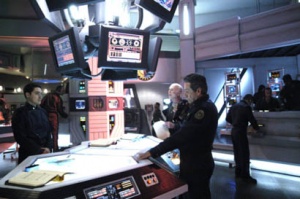
The veteran Colonial battlestar Galactica is centrally operated from the Combat Information Center, or CIC, the battlestar's nerve center.
CIC is a faintly-circular room is located deep in the interior "alligator head" of the battlestar, where the main hull meets the midship section. From CIC, the battlestar's tactical and navigational operations are monitored and directed. CIC is a large, two-level complex with three bulkhead exits, which are closed during action stations alerts.
Galactica's CIC is divided into several stations.
- Command and Control Center
- Communications Station
- Damage Control Station
- Helm Control Station
- Tactical Station
Command & Control Center[edit]
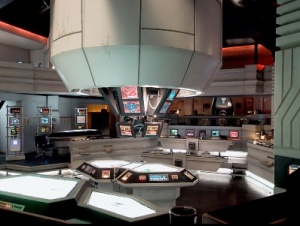
The Command & Control Center features a roughly hexagonal table, lighted from below. There are no chairs; the command staff are always standing.
Here, the battlestar's commander and Executive officer are on station, observing and plotting battle tactics, viewing transparent charts, and giving commands to others in CIC. Above the Command and Control Station are a cluster of monitors known as the DRADIS console. The DRADIS console descends from a cylindrical ceiling recess when required. From the Command and Control Station, the commander has a 360-degree view of the CIC. The DRADIS console contains DRADIS displays but also includes other navigation and tactical information available to the commander at a glance.
The commander of battlestar Galactica in its exodus from the Twelve Colonies is William Adama. His Executive officer is Colonel Saul Tigh.
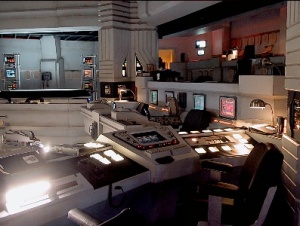
Communications Center[edit]
Adjacent to the Command and Control Center on the port side of CIC is the Communications Center. Here, all communications to and from fighters and other ships are monitored, directed or relayed. In coordination with the Tactical Station, the Communications officer watches for transponders that register as friendly, and alerts the Tactical Officer or commander if they pick up signals without transponders or recognized enemy transponders. The Communications officer has a link to the mainframe computer, where a library of Colonial recognition information resides.
Galactica's primary Communications officer is Petty Officer Anastasia Dualla.
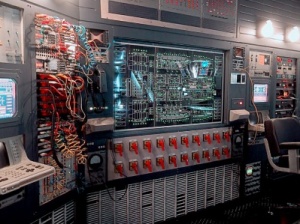
Damage Control Station[edit]
Situated in the far port side of CIC is Damage Control. This station, usually unmanned, contains the Damage Control computers, which connect to many sensors throughout the exterior and interior of the ship. A large display against the wall of the station shows damage through a series of lights that represent the frames, or compartments of the battlestar that form the many segments of the ship.
A commander can order a Damage Control officer to perform many actions to repair or mitigate the effects of an enemy attack through the controls here, including the venting of compartments, coordination of damage control teams, and the like. It is also likely that alternative damage control stations outside of CIC, such as the Aft Damage Control room contain similar controls to aid in repairs, control of fires and the like in the event that CIC's damage control is knocked offline or CIC staff are incapacitated.
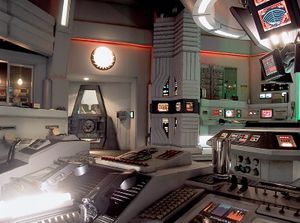
Helm Control[edit]
Battlestars are flown like a submarine navigates in an ocean. While external cameras may be available, they are seldom used in navigation of a battlestar. Navigation is managed by spatial coordinates based on DRADIS and other sensor information. The helm crewmembers drive the battlestar through a series of controls and based on commands from the Executive officer or commanding officer.
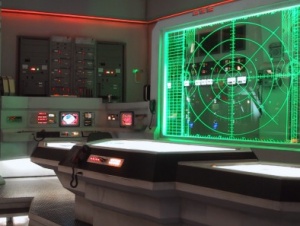
Tactical Station[edit]
The Officer of the Watch/Tactical officer is arguably the busiest officer in Galactica's CIC. Tasked with the monitoring of DRADIS and coordinating various command and control functionality, including computer control, the Tactical Officer must relay changes in status and keep the commander updated continuously during the fluidic events of battle. The Tactical officer is typically the first to know that an attack is imminent and will address the battlestar by the public address system to go to battle stations through Condition One or Two alerts.
As Galactica's computers aren't networked, the Tactical officer must manually print or offload data from the various central computers he monitors (Fire control, Navigation, FTL, and mainframe computers) and relay this information to the other officers and staff in the room. Fortunately, many stations see the same information on displays similar to those at the Tactical Station, but it's the Tactical Officer who is charged with notifying the commander of the changes and interpreting the results. Galactica's Tacthcal officer also is the administrator for all central computers onboard and provides maintenance as required.
While the Helm officers drive the ship, it is the Tactical officer that plots Jumps, the apparently instantaneous leap from one location in space to another location millions of kilometers away. The Tactical officer of Galactica not only has to provide Jump coordinates to the battlestar's helm, but also relay a series of scheduled and emergency Jump coordinates to over 70 other FTL-capable civilian ships that make up the Fleet to ensure that all ships always stay close to Galactica's' protective sphere.
Nearby the Tactical Station is a tactical board and table where the commander can meet with several officers and crew at once for advanced battle or strategy conferences.
The harried but amazingly calm and reliable Officer of the Watch/Tactical officer aboard Galactica is the highly-trained and skilled Lieutenant Felix Gaeta.
Notes[edit]
- The destruction of other battlestars during the Cylon attack hinged on the Colonial's dependence on complex networking within most CICs. It is likely that the battlestars that were destroyed required fewer crewmembers to operate it since they used networked computer systems that moved data around faster than the crew that literally ran between stations in Galactica's CIC with pen and paper or data cartridges to transfer messages and data.
- Unlike her sister battlestars, Galactica is the only one without networked computer systems throughout the ship. This simple design, which was a necessary defense when the ship fought in the first Cylon War, saved it again as almost all other battlestars were shut down and destroyed by the tainted Command Navigation Program. The "CNP" was created by Dr. Gaius Baltar but secretly modified by a Cylon agent with vulnerabilities that could order any ship with the program installed to shut down its own systems. Without the CNP in place and without a central computer network, Galactica was practically immune to Cylon infiltration and infection tactics and was able to mount a defense.
- Humanoid Cylon agents, probably the first copy of Aaron Doral encountered, installed a Cylon Transponder at the base of the DRADIS console shortly before the Cylon attack (Miniseries). Dr. Baltar is aided by his virtual Number Six in identifying it to the CIC command staff. It is likely that the transponder was placed there to track Galactica should it escape Cylon attacks.
- The Mercury class battlestar Pegasus has a differently designed CIC, but likely contains many of all stations found on Galactica. There may be fewer stations since this particular battlestar once used computer networks before the destruction of her sister battlestars and the Colonies.
Cinematic Information[edit]
- Cinematic realism on the CIC set is enhanced with the use of actual submarine hardware, such as thick phones with cords.
- Unlike the command centers of many science fiction space vessels, Galactica's CIC does not have a central viewing screen out into space. There isn't a single window looking out, in fact. Navigation is performed from sensor and spatial data not unlike a submarine.
- The CIC set used for the Pegasus are the modified remains of set hardware intended for use on a revival of the "Lost in Space" television series. When the series project was cancelled, the show's sets were refitted to form the CIC for this advanced battlestar.
- The Sci-Fi Channel official web site incorrectly names CIC as the "Command Information Center." The correct name is verifiable from the center's name that is etched in the glass of the doors of the set.